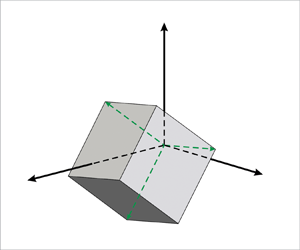No CrossRef data available.
Published online by Cambridge University Press: 18 November 2024

Effects of different filter kernels, namely, spectral cutoff ( $\mathcal {S}$-filter) and Gaussian (
$\mathcal {S}$-filter) and Gaussian ( $\mathcal {G}$-filter), on the geometrical properties of the subfilter stress (SFS) tensor and the filtered strain-rate (FSR) tensor are analysed in a forced homogeneous isotropic turbulence. Utilizing the Euler angle–axis methodology, it is observed that despite similar mean behaviour, the eigenframe alignment between SFS and FSR exhibits a non-trivially different statistical distribution for two different filters. Besides the eigenframe alignment, the eigenstructure of these tensors is also investigated. It is found that in contrast to the eigenstructure of the FSR which does not show sensitive dependence on the filter kernel type, the eigenstructure of the SFS tensor is significantly influenced by the filter type. Subsequently, the impact of different filter kernels on the subfilter energy flux (SFEF) is investigated. It is observed that energy transfer in
$\mathcal {G}$-filter), on the geometrical properties of the subfilter stress (SFS) tensor and the filtered strain-rate (FSR) tensor are analysed in a forced homogeneous isotropic turbulence. Utilizing the Euler angle–axis methodology, it is observed that despite similar mean behaviour, the eigenframe alignment between SFS and FSR exhibits a non-trivially different statistical distribution for two different filters. Besides the eigenframe alignment, the eigenstructure of these tensors is also investigated. It is found that in contrast to the eigenstructure of the FSR which does not show sensitive dependence on the filter kernel type, the eigenstructure of the SFS tensor is significantly influenced by the filter type. Subsequently, the impact of different filter kernels on the subfilter energy flux (SFEF) is investigated. It is observed that energy transfer in  $\mathcal {G}$-filtering is preferably distributed over the forward region, whereas for the
$\mathcal {G}$-filtering is preferably distributed over the forward region, whereas for the  $\mathcal {S}$-filter, the SFEF is more evenly distributed over both forward–backward regions, leading to a heavy energy transfer cancellation. Additionally, by decomposing the SFEF into different partial energy fluxes, it is found that the impact of the
$\mathcal {S}$-filter, the SFEF is more evenly distributed over both forward–backward regions, leading to a heavy energy transfer cancellation. Additionally, by decomposing the SFEF into different partial energy fluxes, it is found that the impact of the  $\mathcal {S}$-filtering on the eigenstructure of the SFS leads to the amplification of the backward energy transfer. Conversely, the
$\mathcal {S}$-filtering on the eigenstructure of the SFS leads to the amplification of the backward energy transfer. Conversely, the  $\mathcal {G}$-filtering amplifies the forward energy transfer by producing a more pronounced alignment between the contractive–extensive eigenvectors.
$\mathcal {G}$-filtering amplifies the forward energy transfer by producing a more pronounced alignment between the contractive–extensive eigenvectors.